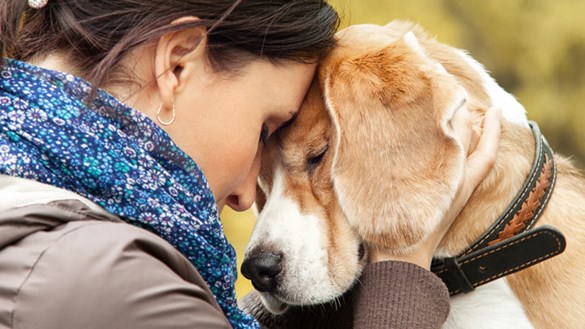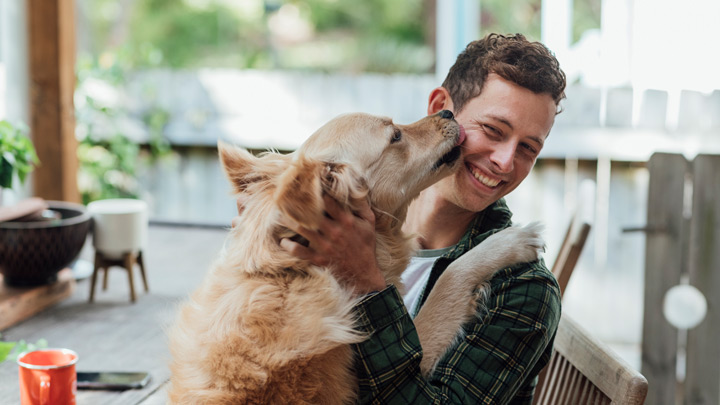Understanding Your Dog's Behaviour
Every dog has their own distinct personality and as a dog owner you love them for it. But have you ever wondered what your pet’s different character traits really mean? It can take time getting to know your canine friend but it’s well worth the effort. Understanding your dog’s behaviour can help you enjoy the companionship and joy they bring.

The long history of man’s best friend
Dogs were first domesticated thousands of years ago when wolves started gathering around the village rubbish dump for food. With time they moved closer to the people, who noticed they had certain traits that were useful in everyday life. Ancient humans then started to enhance some of these traits including guarding, tracking, or herding through selective breeding. Selecting for specific traits also came with specific looks, hence our modern-day dog breeds were born. Despite their domestication, natural guarding or hunting behaviours still apply to many breeds.
As dog lovers we form strong bonds with our pets, enjoying the companionship and joy they bring. And just like humans, dogs feel emotions too which they display through their behaviours.
Common dog behaviours
You’re probably aware of your dog’s normal behaviours – barking, biting, chewing, digging, licking, jumping etc. Your dog might be an avid tail wagger or affectionate nuzzler but whatever it is, they’ll do things you notice more than others.
A lot of their behaviour will be instinctive. Jack Russells, for example, love to dig because they were bred to catch rodents – it may be annoying for you if you have a lovely lawn you want to keep neat but for them it’s in their make-up. Dalmatians are full of energy, very playful and can run and run. It’s no surprise then to learn they were once coach dogs trotting alongside carriages to protect them from other dogs and horses.
These behaviours are all normal and simply a sign they’re doing what nature intended. While some of them can be a little annoying they’re all part and parcel of being a dog owner. However, by identifying when a behaviour turns from normal to concerning, you can nip any issues in the bud early on.

What does my dog’s body language tell me?
Your dog can’t tell you what they’re thinking so they’ll use their body to show you. A wagging tail is a sign of emotional arousal but it’s not always excitement, it can also be a sign of frustration too. Tail up can signify they’re happy while tail tucked between their legs can show stress and fear. This is one of the reasons why docked tails can make reading a dog’s body language so difficult, both for owners and other dogs. Similarly, a dog with its heckles raised isn’t always a sign of aggression or fear; it can also indicate excitement or intense interest.
Your dog’s posture can shed light on their mood. For example, a hunched or cowering dog is usually stressed or fearful while a dog with its weight shifted forward indicates interest in something. It could also show aggression though if coupled with other signs such as a high tail or your pet appearing to make itself seem larger.
A belly rub can be a sign of playfulness, but it can also be a sign of extreme stress and anxiety – some dogs will roll onto their backs to expose their bellies to show they mean no harm. On the other hand, you can be sure a dog which places its chest on the ground with its bum in the air wants to play.
How dogs show affection
Some signs of affection are obvious but there are others even lifelong dog lovers can miss. They may not be able to tell you they care but they can certainly show you. A wagging tail, following you around, licking your face, jumping on you, sleeping near you, rough housing, watching over you when you’re sick, guarding you while you eat and even sniffing your crotch are all signs they love you. But did you know gazing into your eyes, bringing you broken toys and sighing can show contentment too.
How dogs show aggression
On the flip side, while aggression is also a normal way of communication between dogs it can be undesirable when directed at humans. Signs include growling, barking, snarling, giving a hard stare, snapping, biting, lunging, baring their teeth and standing very still and rigid. Dogs normally start showing aggression on the lower end of the scale to give a warning. It is therefore important never to tell a dog off for growling as this might cause them to skip the warning step next time and lunge straight into snapping or biting.

Abnormal dog behaviours
- Barking – If you own a dog, you can expect a bit of a barking. But when it’s constant and the neighbours are complaining you know it’s become a problem. Figuring out why they’re barking excessively is the first step to improving things. If they always bark when the doorbell rings it could be territorial, if he’s trying to get your attention, they could be insecure or they could simply be very excited to see you.
- Biting – Biting is normal pup behaviour but when it extends into adulthood or harms people it becomes abnormal. Some bite because they feel threatened or are protecting territory, some do it because of naturally aggressive tendencies and are simply dangerous. Early socialisation and training can help your dog if they’re prone to biting.
- Chewing - Puppies are born chewers, especially as they cut their adult teeth. It’s great for them but not so great for your furniture. Most grow out of this phase but a few develop a taste for it, and you can be left pulling out your hair wondering how to stop it. You can reduce the chewing by providing them with chew toys or crating them when they’re unsupervised. Crate training should be started early and gradually for a crate to be seen as a safe place rather than a punishment.
- Digging – Digging is natural and for some breeds it’s a dominant part of their nature. Dogs will dig to bury treats or find a cool patch of earth to rest on. But if your garden is suffering, try to identify the root cause. If it’s boredom, try chew toys or playing with them to distract. Nasty smells can put them off too. Consider also sacrificing a small part of your garden as a digging patch by burying their favourite chews and sweets to limit the damage to one place.
- Chasing - This is instinctive, particularly if they’re a breed known for its hunting or herding characteristics, but it can put both your dog and the person or animal they’re chasing in danger. Early training can improve your dog’s recall, so they learn to return to your side when their name is called rather than continue the chase. If that doesn’t work, keeping them on the lead when out in public might be the only option.
- Licking – Dogs lick to show affection, get your attention, to soothe themselves or simply because they like the way you taste. Excessive licking could be a sign they’re anxious. Because licking is part of their natural grooming, it is a self-reinforcing behaviour and can become a habit. If you feel the licking is becoming too much try and distract them with chew toys or treats and offer lots of positive praise when they exhibit the behaviour you want rather than negative comments when they don’t.
Learning to read your dog’s body language can be very rewarding, picking up small changes before they become a problem and removing your pet from negative situations before they escalate. If you are unsure if your dog’s behaviour is normal or not, consult with your nearest practice who may refer you to a specialist behaviourist if appropriate.

